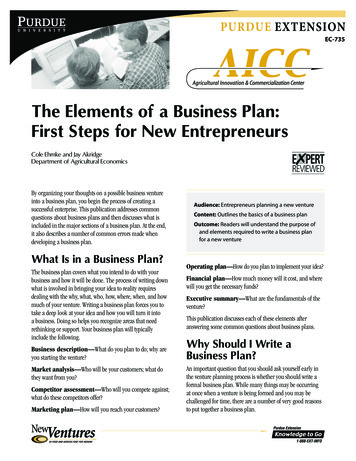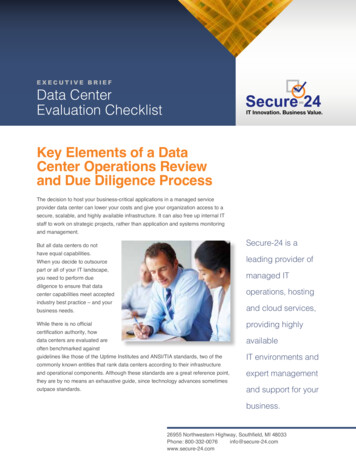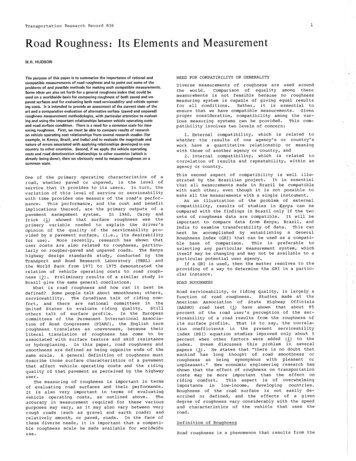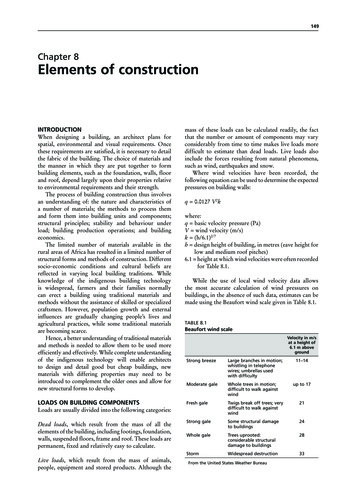
Transcription
Purdue ExtensionEC-735The Elements of a Business Plan:First Steps for New EntrepreneursCole Ehmke and Jay AkridgeDepartment of Agricultural EconomicsBy organizing your thoughts on a possible business ventureinto a business plan, you begin the process of creating asuccessful enterprise. This publication addresses commonquestions about business plans and then discusses what isincluded in the major sections of a business plan. At the end,it also describes a number of common errors made whendeveloping a business plan.What Is in a Business Plan?The business plan covers what you intend to do with yourbusiness and how it will be done. The process of writing downwhat is involved in bringing your idea to reality requiresdealing with the why, what, who, how, where, when, and howmuch of your venture. Writing a business plan forces you totake a deep look at your idea and how you will turn it intoa business. Doing so helps you recognize areas that needrethinking or support. Your business plan will typicallyinclude the following.Business description—What do you plan to do; why areyou starting the venture?Market analysis—Who will be your customers; what dothey want from you?Competitor assessment—Who will you compete against;what do these competitors offer?Marketing plan—How will you reach your customers?Audience: Entrepreneurs planning a new ventureContent: Outlines the basics of a business planOutcome: Readers will understand the purpose ofand elements required to write a business planfor a new ventureOperating plan—How do you plan to implement your idea?Financial plan—How much money will it cost, and wherewill you get the necessary funds?Executive summary—What are the fundamentals of theventure?This publication discusses each of these elements afteranswering some common questions about business plans.Why Should I Write aBusiness Plan?An important question that you should ask yourself early inthe venture planning process is whether you should write aformal business plan. While many things may be occurringat once when a venture is being formed and you may bechallenged for time, there are a number of very good reasonsto put together a business plan.
First, a business plan helps provide direction by making youdiscuss where you want to take the venture and define whatyou want out of it. Second, a business plan provides structureto your thinking and helps you make sure you’ve covered allof the important areas. Third, a business plan prompts you tothink about the future. For instance, a business plan mighthelp you consider what you would do when, once yourventure is developed, it attracts several competitors. A goodbusiness plan will include ideas for dealing with new competitors in your market, helping you prepare your business forthis situation.Finally, a business plan will help you communicate youridea, not only to financers, but also to employees, potentialemployees, suppliers, and customers. As a communicationtool, a carefully developed plan will provide something thatother people can react to. You can use their insights to helpyou develop a more successful venture.Who Should Write the Plan?The person or persons responsible for implementing the planshould be heavily involved in its development. Some peoplehire consultants or have employees draft the plan. If you’regoing to be accountable for the decisions that will be based onthe plan, then you need to be involved in its development. Youmight have input from experts as you develop the backgroundand analysis for the business plan, but the business venture isan extension of your desires, goals, philosophies, skills, andabilities. If you are not directly involved, then it will not be aneffective planning document.How Long Should aBusiness Plan Be?Part of the answer to this question depends on the audiencefor your plan. If you are going to use the plan to search forequity capital from a potential investor, then the plan shouldbe comprehensive and detailed. It should certainly be longerand more detailed than a plan that is developed only forinternal use by yourself and a partner.But more important than length is what the plan says. Somelong plans may communicate very little, while some veryshort plans concisely communicate the essence of the venture. Thoughtfully and thoroughly considering all the areas of theplan is much more important than attempting to reach acertain length.Elements of a Business PlanSection 1. Business DescriptionAs an introduction to your business, this section shouldprovide an overview of the business and its objectives. Readersof your business plan will want to know why this businessshould exist. Having a mission statement will help communicate this.Mission StatementAs you begin your business venture, the first step is to clarifywhat is most important to you. Having a clear purposeprovides readers with the context for the venture and willgive it meaning. Often a statement of purpose—a missionstatement—is written to outline intentions and motivations.To write a mission statement, first consider the things youcare about or want to do. A mission statement communicatesthe purpose and principles of what you’re doing and whyyou’re doing it. A good mission statement should accuratelyexplain why your venture exists and what it hopes to achievein the world. Write a brief paragraph that is free of jargon. Atthe very least, your mission statement should answer three keyquestions:1. What are the opportunities or needs that you exist toaddress? (the purpose of the venture)2. What are you doing to address these needs? (thebusiness of the venture)3. What principles or beliefs guide your work? (thevalues of the venture)Your mission is the beacon for your venture. All other actionsin your business plan should help you accomplish the mission.Communicating your mission with clarity is importantbecause the goals you set, actions you take, and the way youspend your time will be guided by this statement. See PurdueExtension publication Developing Vision and MissionStatements (EC-720) for more information on this topic.Purdue Extension Knowledge to Go
Figure 1 contains an example of a thoughtful, fully developedmission statement, that of Ben & Jerry’s, the quirky, innovative, highly successful ice cream manufacturer.Ben and Jerry’s mission statement is specific and actionoriented. It describes exactly what the business of the ventureis and mentions the quality ideals it sets for its products. Itdirectly states that the company will focus on increasingprofitability to enhance value for shareholders, yet it commitsFigure 1. Ben & Jerry’s Mission StatementBen & Jerry’s is founded on and dedicated to asustainable corporate concept of linked prosperity.Our mission consists of three interrelated parts:ProductTo make, distribute and sell the finest quality allnatural ice cream and euphoric concoctions with acontinued commitment to incorporatingwholesome, natural ingredients and promotingbusiness practices that respect the Earth and theEnvironment.EconomicTo operate the company on a sustainable financialbasis of profitable growth, increasing value for ourstakeholders and expanding opportunities fordevelopment and career growth for our employees.SocialTo operate the company in a way that activelyrecognizes the central role that business plays insociety by initiating innovative ways to improve thequality of life locally, nationally and internationally.Central to the mission of Ben & Jerry’s is the beliefthat all three parts must thrive equally in a mannerthat commands deep respect for individuals in andoutside the company and supports thecommunities of which they are a part. the company to taking an interest in broader social issues.Thus, the firm’s values are clear.Business OverviewAlso included in the Business Description portion of a businessplan is a summary of the current state of the venture. If youalready have selected a legal structure (sole proprietorship,partnership, Subchapter S, or C corporation), then describe itand who the principal owners are. Also provide a definitionof the business—is it a manufacturer, retailer, wholesaler,service provider, or some combination? Will it be startedfrom scratch, as an expansion, or as an acquisition? Furtherinformation may include the history of the business and itsprimary strengths.Products and ServicesReaders of your plan will need a description of what yourproduct or service is to provide context for what you will latersay about it and your market. A general description is all thatis needed in this section; you can provide more depth in themarketing plan section.Section 2. Market AnalysisThis section is the place for you to discuss the market andyour approach to it. In it you describe the market’s characteristics, your target customer’s profile, the competition, andhow you plan to gain an advantage over them to create asuccessful venture.Market CharacteristicsYour business will be a part of an industry. Describe theindustry so readers can understand the market place. Includeinformation on its size, location, history, competitiveness, andprofitability as well as its general health. In particular, discussthe current trends in opportunities and threats. This foundation will help you prove that a market exists for your product.Your research will be the foundation of your forecasted saleslevels and will directly influence how large your operationshould be, your marketing plan, and the financing required.Your efforts to reach your potential market and create a profitwill be limited by other businesses involved in the industry.For instance, if the only way to effectively distribute yourPurdue Extension Knowledge to Go
product is through a large national chain, then that chainwill likely use its bargaining power to force you to sell for alower price, or there may be a slotting fee involved. You willwant to discuss forces like this and how you will respond tothem. These forces include the following: Supplier power (suppliers’ bargaining power andleverage), New competitors (the threat of entry of new rivals), Substitute products (ease with which buyers canswitch to alternative products and/or attempts ofoutsiders to win buyers over to their alternativeproducts), Buyer power (buyers’ bargaining power andleverage), Industry rivalry (intensity of rivals’ jockeying fora better market position and a competitiveadvantage), and Government regulations (government influencethrough regulations and policy).See Purdue Extension publication Industry Analysis:The Five Forces (EC-722) for more information on thistopic.Target Customer ProfileIn writing your market analysis, you will narrow the rangeof potential customers to those specific ones who are willingand able to buy your product. Although your product orservice may meet the needs of a large constituency of potential customers, the goal is to define your target customer asspecifically as possible both quantitatively and qualitatively.As you gather your information, you will build a profile ofyour target customer.Your research should provide demographic informationabout who you’ll focus on and the psychographic information to understand why customers buy products. This willallow you to focus your efforts efficiently. Thorough anddetailed research sets a good business plan apart from anaverage one. If you are selling to consumers, then consider the following. Are your customers local, regional, national, and/orinternational? Are your customers young, old, male, female, highincome, low income, etc.? Are there behavioral characteristics that differentiateyour customers? (for instance price shoppers versusconvenience shoppers) Are there cultural considerations, social connections,or other personal factors that might shape yourcustomer’s needs, wants, and buying behaviors?If your customers are primarily businesses, then considerthe following. Do business customers’ needs differ by industry? Do business customers in different regions havedifferent needs? Who in the business is involved in the purchasingdecision? What is their job function? Who influencestheir decisions? What is their background andknowledge with respect to your product/service? What are company buying policies and procedures,financial constraints, and timing of purchases?Potential information sources are often publicly available,and you should augment them with interviews with peoplecurrently in the industry as well as your own experience. Youshould also include a statement of the potential opportunitiesfor growth.Section 3. Competitor AssessmentIn your market analysis, include a review of your specificcompetitors. All businesses have competitors in some form.Some competitors sell similar products, while others sell aproduct that serves the same function. Established businesseswill likely not take your entry into the market lightly.First, define who your competitors are, and then profile them.You should assess competitors with a critical eye on theirstrengths and weaknesses compared to your own. It isimportant to have an understanding of the operations of yourPurdue Extension Knowledge to Go
competition so you know how you stand in relative terms.Keep in mind the customer profile you created earlier. In ityou discussed the customers’ needs. In this section, addresshow your competitors fill those needs and what you, in turn,will offer. If a competitor has a strong competitive advantagein an important area, you need to discuss how you willaddress it. When reviewing competitors, consider what theyhave as far as: Market share, Relationship with customers, Advertising plan, Price, Distribution, Product/service features, Financial strength/cost position, and Length of time in business.Section 4. Marketing PlanMarketing plans usually address four areas: product offered,price charged, distribution system, and promotional efforts.Products and ServicesIn your business description, you described your product orservice in general terms. In this section, describe your productand how it will be used. This is your chance to explain yourproducts/services, identify their features and benefits, anddiscuss what needs or problems they address in the market.If you will offer a product, describe what it is, what it does,and its features and benefits. Include pictures, drawings,or technical images if they would help readers get a betterunderstanding of your product. Discuss its size, shape, color,cost, design, quality, capabilities, technological life-span, andpatent protection. You may also wish to explain how it isproduced, the materials required, and the type of labor needed.If you will offer a service, explain what the service is and whatneed it addresses for your target market. Describe how you willperform the service (whether it is on site or via the Internet,telephone, or some other method), what makes it different,and what materials or equipment are needed. The products you offer will include aspects beyond the productitself, like packaging, product support, warranties, returns,training, and service. Discuss how these supporting features,services, and information will make your business competitiveand profitable.PricingPricing strategies are based on the perceived value of yourproducts and services, your cost of doing business, yourmarketing goals, and expected competitive actions. A widerange of pricing strategies are available, from simple rulesof thumb to sophisticated approaches that involve carefullymeasuring the value delivered by your firm to your targetmarket.As you make your pricing decisions, it will be helpful to thinkabout your cost to produce your product or service. This willprovide a “floor” on your price. You should also think aboutwhat other products similar to your products sell for in themarket. Finally, give some thought to why the price of yourproduct or service should be above or below the “marketprice.” Above all, demonstrate that your price will allow youto create a profit. See Purdue Extension publication Estimating Breakeven Sales for Your Small Business (EC-725) formore information on this topic.DistributionIn the distribution portion of your marketing plan, describehow your product/service will be distributed and over whatgeographical area. Distribution decisions concentrate on themethods and channels of delivery that will optimize your salesand profits. Logistics management plays an important role inthese decisions as firms determine how products will physically move from manufacturer to customer. Issues of cost andefficiency, timeliness, freshness, customer service, customeraccess, and control all affect your choice of distributionchannel.Describe how your product will be sold, whether throughretailers, direct sales, and/or other methods. Discuss anyrelationships you have developed with distributors or anylicensing agreements you have. Describe how your productwill reach customers, including specific distribution channelsand geographic areas.Purdue Extension Knowledge to Go
PromotionPromotional activities are designed to communicate the valueof your products and services to your customers, ultimatelyleading them to purchase your product or service. The rangeof promotional tools available to you is very broad and maybe a combination of advertising, personal selling efforts, andgeneral public relations activities.An effective promotional plan must focus on your targetsegment—what is the most effective and efficient way to getyour message in front of this group? The second big issue isbudget—how much money do you have to invest in promotional activities? Finally, a promotional plan must includea timeline for activities—when should you pursue theindividual activities in the plan? Creativity is very importanthere—a low-cost, creative promotion may be far moreeffective than an expensive (paid) advertising campaign.See Purdue Extension publication Marketing’s Four P’s:First Steps for New Entrepreneurs (EC-730) for moreinformation on this topic.Section 5. Operating PlanThe operating portion of the plan deals specifically with theinternal organizational structure, operations, and equipmentyou will need to operate your venture. You should discuss howthe business will be owned and managed, your personnel andphysical resource needs, and the legal issues you will have.Ownership and ManagementIn this section, describe the ownership of your venture, andexplain how the business will be managed on a day-to-daybasis. For instance, if your venture will operate as a partnership, then explain who the partners are and how management decisions will be made and disagreements will beresolved. For a business organized as a corporation, describethe composition and function of your board of directors, whothe principal owners will be, and how each will be involved inmaking decisions.Managers of a venture are responsible for turning an idea intoa successful business. In this section, describe what qualifiesyou and any other managers or advisors to manage andoperate the business. You should select managers with aneye to balancing technical, managerial, and financial skills.Provide a short profile of the relevant training, experience, licensing, or other indicators of ability that you want yourkey managers to have.Consultants can help you define and implement your plans.Outline the outside advisors you will be using to help runyour business, and provide a few sentences that describeeach individual’s affiliation and qualifications. See PurdueExtension publication Selecting and Managing Consultants(EC-719) for more information on this topic.After describing who the key people are, you will want todescribe how you will organize each person’s responsibilitiesand authorities for the efficient operation of your business.A useful management tool to use is a job description for eachposition in the venture. A job description defines in advancewhat the roles of each individual will be and helps incommunicating job expectations. See Purdue Extensionpublication Developing Effective Job Descriptions for SmallBusinesses and Farms (EC-728) for more information onthis topic. An organizational chart of the positions requiredand job descriptions for the key employees will help readersunderstand how the business will operate. See PurdueExtension publication Principles for Structuring SmallBusinesses and Farms (EC-729) for more informationon this topic.Resources and ProductionOther StaffingIf you will need to hire employees apart from yourself andother owner/operators, then describe what your personnelneeds will be. Have job descriptions (including job responsibilities and authorities, compensation, and qualifications)for relevant positions, and describe how you will find andmanage the right people.Production MethodsOutline the methods you will use to produce your product(or conduct your service), especially for a manufacturingventure. Pay particular attention to which actions will bedone within your business and how you will you source theinputs you require. Part of this should be estimates of yourproduction costs.The technical feasibility of producing and distributing theproduct will be an important aspect of many ventures.Address the availability of inputs and skilled labor, theviability of production technology, the logistics of productPurdue Extension Knowledge to Go
production, and the environmental effects of production inyour plan.Section 6. Financial PlanOperationsDescribe how your business will be operated in terms of bothschedule and procedures. Your schedule may be part-time orfull-time, may only operate in certain seasons, may observecertain holidays, or may have extended hours at times ofthe year.The financial plan is a necessary part of evaluating a newinvestment opportunity. With it you develop an estimate ofyour profit potential. It can even become an operating planfor the financial management of the venture. In this section,describe the current financial status and present forecasts offuture financial statements. If you are using the business planto seek financing, cover the type and amount of financingplanned (and its repayment terms) as well as the potentialreturn on investment. The financial portion of your businessplan will be examined closely by those interested in joiningyou, investing in the venture, or lending you money, so itmust be thorough. They will want to know how you will useinvested funds to create a successful venture.Operationally, describe how you will manage your business. Amanufacturer will want to describe how raw materials will beobtained and transformed into a finished product. A serviceprovider will want to describe where, when, and how theservice will be performed. Your operational description shouldalso include your polices and procedures for billing andcollections, contract management, inventory control, recordkeeping, and how you will maintain quality.Forecasts of product demand, revenues, and expenses for newventures will draw on the market research you conducted.Your projections are only as good as your assumptions, somake sure they are valid and realistic. Document as muchas you possibly can, including how you developed yourassumptions. Purdue Extension publication Fatal BusinessPlanning Assumptions (EC-734) discusses financial andgeneral planning assumptions.Legal IssuesProvide projections for two to four years in the future,including:Facilities and EquipmentEstimate what facilities and equipment you will use andwhere they will be located in relation to your suppliers andcustomers. Describe the size and usefulness of the facilitiesand any modifications needed to start operations and asyour business grows.Intellectual Property ProtectionProtecting your business and its products from imitatorsshould be a concern early in your venture, particularly if youhave innovative products. Trademarks and service marks willprotect your company’s marketing symbols for products andservices. Patents will help protect the products you create.See Purdue Extension publication Intellectual Property:Obtaining Patents, Trademarks, and Copyrights(EC-723) for more information on this topic.ComplianceEvery business is subject to local, state, and federal regulation.Outline your plan for complying with relevant regulations.See Purdue Extension publication Licensing, Regulatoryand Tax Requirements for Indiana Businesses: A ChecklistGuide for New Businesses (EC-733) for more information onthis topic.If you have applied for and received a Tax IdentificationNumber from the federal government, then include it here. 1. Forecasted income (monthly for first two years,then by quarter or year thereafter),2. Forecasted cash flows by month (monthly for firsttwo years, then by quarter or year thereafter),3. Forecasted balance sheet for all years (year-end), and4. Breakeven analysis.Many small businesses will have very limited revenue for thefirst two years of operation. Most small businesses will notmake a real profit for at least two to three years. Withoutsignificant financial reserves, your venture is likely to fail.You can use a convincing business plan to gain capitalneeded to get beyond the initial difficult years. If the purposeof your plan is to seek funding, request those funds, anddescribe how they will be used.As with any venture, there will be risks. Identify and describethe most threatening risks to your success. Outline theactivities you will pursue to manage the risks.Purdue Extension Knowledge to Go
Section 7. Executive SummaryBusiness PlannerThe executive summary is your chance to highlight theimportant aspects of your venture. As a summary of yourplan it should be short. Try to fit it on one page. It shouldgive highlights of the following features:INVenture http://www.agecon.purdue.edu/planner is atool to use to start writing your own business plan online.This Web site helps users build a business plan by asking keyquestions. Users’ responses are collected and can be exportedto MS Word in the form of a business plan. Your mission and goals, The product, The market and its potential, The marketing plan, The management team, Key elements of your operations, Funding requirements, and profit and cash forecasts, Return to the investor.Final CommentThe components of a business plan cover an array of topicstypical to all ventures. However, what you write in yourbusiness plan will depend heavily on how you intend to usethe plan. One use is as a feasibility study—a way to helpexplore an idea to find out if it makes sense. Another is as anoperating guide—a plan that details how a new venture willprogress and operate. Another way a business plan can beused is as a financial proposal—a plan that communicateshow an investor’s financial support will be rewarded.Each use will emphasize different areas. For instance, if youare intending to take your business plan to an investor, then itshould focus much more attention on how money will beused and repaid than a feasibility study would. If you arewriting a feasibility study, then you may have much moremarket analysis and technical information than an operatingplan would.Planning is a continuous process. Once you have writtenyour business plan, you should not consider it finished. It isa document that will guide the formation and growth of yourbusiness you should continually revisit it, especially if themarket or your initial assumptions should change. If thechanges are significant, then you should be prepared torevise or even scrap your plans. Purdue Extension ResourcesYou can purchase the Purdue Extension publications belowand others about starting a new venture at https://secure.agriculture.purdue.edu/store/ . You can download all exceptEC-733 at www.ces.purdue.edu/extmedia/agecon.htm#1 . Capital Investment Analysis and ProjectionAssessment, EC-731 Defining Your Business Through Goals andObjectives: First Steps for New Entrepreneurs,EC-727 Developing Effective Job Descriptions for SmallBusinesses and Farms, EC-728 Developing Vision and Mission Statements,EC-720 Estimating Breakeven Sales for Your SmallBusiness, EC-725 Fatal Business Planning Assumptions, EC-734 General Licensing, Regulatory and TaxRequirements for Indiana Businesses: A ChecklistGuide for New Businesses, EC-733 How to Use Goals to Achieve Business Success:First Steps for New Entrepreneurs, EC-726 Industry Analysis: The Five Forces, EC-722 Intellectual Property: Obtaining Patents,Trademarks, and Copyrights, EC-723 Marketing’s Four P’s: First Steps for NewEntrepreneurs, EC-730 Principles for Structuring Small Businessesand Farms, EC-729 Selecting and Managing Consultants, EC-719Purdue Extension Knowledge to Go
Common Business Plan ErrorsNot Creating a PlanEntrepreneurs have many reasons for not completing abusiness plan—not enough time, don’t believe it will beuseful, not sure where to start, and so on. Not creating abusiness plan is a fundamental error for an entrepreneur.In fact, when reviewing an unsuccessful venture, manyfind their biggest mistake was not taking the time to thinkthrough what it would take to make their venture successful. While a complete, well-developed plan is the goal, anincomplete business plan is better than no plan at all. Evenan incomplete plan will move you in the right directionand provide something to which others can respond.Readers of your plan will be able to see what is missing andcan point out flaws in your logic if they have something tocritique.Incomplete Market ResearchMany times information about the market for your productor service is the most difficult to gather. Trying to gaugewho wants your product, how much they want, what theywill pay, and how competitors will respond is not an easytask. While challenging, the time and energy invested intruly understanding your market will pay off. Your businessshould be market-driven rather than product-driven. Yourbusiness plan should not be built around a productsearching for a pro
marketing plan section. Section 2. Market Analysis This section is the place for you to discuss the market and your approach to it. In it you describe the market’s character-istics, your target customer’s profile, the competiti











